|
Ampeer Paper Subscriber Reminder
When subscribing to or renewing the paper version of the Ampeer, please make the check payable to Ken Myers. We do not have a DBA for the Ampeer or EFO. Thanks, Ken
Correction/Clarification for The "Skinny" On A123 Cells
Article: March 2008 issue
In the March issue I stated, "Important Note: the "button" end of these cells is the NEGATIVE"
When I originally wrote the article I was only referring to the ANR26650M1 2300mAh cells.
I've changed that statement so that it now reads, "Important Note: the "button" end of the ANR26650M1 2300mAh cells is the NEGATIVE"
The APR18650M1 1100mAh cells use the "normal" button POSITIVE mode.
Always use a meter when working with cells and making battery packs!
Return to "What's In This Issue"
How I Have Been Zip Charging a 3S1P ANR26650M1 (2300mAh) A123 System, Inc. Pack
By Ken Myers - March 2008
Warning: What you are about to read is what I am doing, NOT what I am recommending anyone else to do! Under NO CIRCUMSTANCES should you consider doing the following unless you have the proper electronic tools, skills and knowledge! This is not a how-to but a how I did it. Improper use of this information could lead to personal injury and property damage.
"Zip Charging" is a term coined by Charles (everydayflyer) on RC groups to describe the charging method where a length of 16/17/18 gauge "zip cord/lamp cord" is used to directly charge a 3S pack of ANR26650M1 or APR18650M1 cells from A123 Systems, Inc. with a direct connection to a 12v Marine/RV battery. A meter, like the Astro Flight Whattmeter, is inserted inline to monitor the charge.
This method may ONLY BE USED with 3-cell packs (or combinations thereof) of the aforementioned cells. Under no circumstances should this method be used with any other battery type or cell chemistry.
This type of charge can be terminated automatically. Dan Baldwin has plans for the "Terminator" on RC Groups. It is a DIY project. (www.rcgroups.com/forums/showthread.php?t=795122#post8844692) For now, I manually terminate.
On Sunday, March 2, I charged the 3S pack for the Son of Swallow for the first time using my unmodified Astro Flight 109 charger. Once I felt it was charged, I started discharging. While doing the initial charge, I used my very old Astro Flight Whattmeter inline with the charger and battery to see how it reacted to the charge.
One interesting observation was that during Mode 1 of the AF 109 charger the Whattmeter averages the numbers as the charger does its "checking." Once in Mode 2, the charger numbers did not agree with the numbers displayed on the Whattmeter. To get the AF Whattmeter to "read" 2.3 amps during the charge, I had to set the charger to 2.5 amps. Also, the voltages displayed on the two devices were quite a bit different, with the Whattmeter being 0.2 of a volt or more lower. While investigating the charge, I also tried my Hyperion Emeter, but wasn't quite sure what I was doing with it being used this way.
I then discharged the charged pack using the AF 109. During the discharge, I attached the CellMeter-8 from Hobby Lobby and found that once discharging, all three cells of the pack were reading exactly the same voltage, whenever I measured them, even though the individual cells had not read exactly the same before the discharge started. The discharge took about an hour and fifty minutes. I did not record the mAh taken from the pack, as I had stopped the discharge and "played" with the different meters a bit.
I then charged up the pack again and let it set over night. The voltage readings in the morning were 3.45v, 3.54v and 3.54v. I topped off each cell individually using the unmodified AF 109 until they all read 3.74 while resting.
I set up a discharge of the pack using the AF 109. I left the knob zeroed, as it has no affect on the discharge, hooked the charger up to the 12v Marine/RV battery and then hooked up the 3S pack for discharging. I went upstairs and set the timer for twenty minutes, as I wanted to monitor the pack during the discharge.
If you own an AF 109, you know what I did wrong. To discharge a pack using the AF 109 you hook up the battery pack to be discharged FIRST, not the Marine/RV battery! That's right, I charged it for another 20 minutes! Yikes.
When I discovered my error, I used the CellMeter-8 and found all three cells to have a "surface" charge of just over 4v. After an hour, they had settled down to about 3.85v per cell.
They sat for another 15 minutes and then I put my AF 123 Blinky on the pack for 10 minutes. At the end of the ten minutes the CellMeter-8 read the voltages as 3.677v, 3.691v and 3.655v. When hooked up correctly in Discharge mode, the AF 109 read an initial 10.84v.
It took 110 minutes to discharge 2220mAh. The "bounce back" voltages after resting for a while after the discharge were 3.148v, 3.163v and 3.161v.
For the first Zip Charge the total length of the cord and AF Whattmeter was 18 ft., as this is what I had remembered the length being from the discussion of in "$10 3S A123 charger" on RC Groups. (www.rcgroups.com/forums/showthread.php?t=747911)
Apparently, I had remembered incorrectly.
During the first charge, I panicked a little and didn't really let it complete the charge. When I saw the Whattmeter reach 11.4v, I terminated the charge. I should not have terminated it at that point because only about 2085mAh had been returned to the pack. The highest amp draw that I saw near the beginning of the charge was somewhere just over 10 amps, and it went down to about 2.9 amps just before the early termination. For about twelve minutes of the charge the amperage was between 7.4 and 5.0 amps. That was much lower than I had hoped for.
The cell voltages, after resting a half hour, were only 3.429v, 3.438v and 3.424v, which is not really a full charge, but close. I "A123 Blinkied" to equalize the pack and then started another discharge.
I shortened the Zip Cord/lamp cord by three feet, to fifteen feet total including the Whattmeter, for the second Zip Charge. I also kept better records during the charge process. The second charge ran sixteen minutes and put in 2145mAh, according to the Whattmeter. That is an average of about 8 amps during the charge, or about a 3.5C charge rate. The highest amp reading I saw at the beginning of the charge was a little over 13 amps, but it went down quickly to the 9-amp range with the amp reading being 9.4 amps at two minutes into the charge. Even though the charge was terminated at 11.9v on the Whattmeter and at the sixteen minute mark, I am not sure that I actually filled the pack because a half an hour after the charge was terminated, the cells read, 3.583v, 3.534v and 3.551v on the CellMeter-8. The cells were barely warm to the touch immediately after the charge.
The battery was equalized to 3.52 volts per cell, and once again discharged. Another three feet was clipped off the Zip Cord/lamp cord, making the total 12 feet. The battery was "Blinkied" after the discharge to about 3.12v per cell.
The pack was recharged. The voltage on the Whattmeter read 10.2v when plugged in and showed 16.3 amps. After two minutes of charging, the voltage was up to 10.4v and amperage down to 11.2. The amps declined from 11.2 at 2 minutes to 7.4 at the end of 12 minutes and 2078mAh had been returned to the pack. Not wanting to terminate too soon, I allowed the pack to stay connected for another 3 minutes, during which time the amps went from 3.2 to 0.8 and 132mAh was added to the pack for a total of 2210mAh. The "surface" voltage read by the CellMeter-8 immediately after the charge was approximately 4.0v per cell.
After the charge, the pack was warmer than the second charge, but it definitely was not hot!
The pack was left to rest overnight and then the CellMeter-8 read the voltages as 3.761v, 3.690v and 3.691v while my Radio Shack #22-168A multimeter read them as 3.76v, 3.69v, and 3.69v.
The Astro Flight Blinky for A123 cells was used to balance the pack before discharging again. 2245mAh was discharged from the pack.
I cut another three feet from the zip cord/lamp cord and started another charge. Since this is where I've decided to leave the length, the following data from the AF Whattmeter describes the charge.
| 0 min. | 10.2v | 20.1 amps | 0.000Ah |
| 1 min. | 10.6v | 13.6 amps | 0.273Ah |
| 2 min. | 10.6v | 13.1 amps | 0.500Ah |
| 3 min. | 10.6v | 12.7 amps | 0.722Ah |
| 4 min. | 10.6v | 12.5 amps | 0.940Ah |
| 5 min. | 10.6v | 12.3 amps | 1.140Ah |
| 6 min. | 10.6v | 11.8 amps | 1.350Ah |
| 7 min. | 10.7v | 11.3 amps | 1.539Ah |
| 8 min. | 10.7v | 11.1 amps | 1.737Ah |
| 9 min. | 10.8v | 10.5 amps | 1.911Ah |
| 10 min. | 11.0v | 8.2 amps | 2.079Ah |
| 11 min. | 11.7v | 3.6 amps | 2.165Ah |
| 12 min. | 12.0v | 1.5 amps | 2.208Ah |
The surface charge cell voltage readings immediately after the charge, using the CellMeter-8, were all around 4.0v, but quickly started to settle. The temperature of the pack had risen from 58-deg F to 80-deg F at the end of the charge. The pack felt significantly warmer than any of the previous charges, but not hot!
During the charge, because I sometimes had my hand in the proximity of the zip cord and Anderson Power Pole connectors, I could feel them giving off some heat.
Approximately six hours after the charge the CellMeter-8 showed the following; 3.732v, 3.638v and 3.682v. The AF "A123 Blinky" was used to bring the pack back into balance.
Throughout the Zip Charger adjustment process, I noted that the most positive cell seemed quite different from the other two cells. It always discharged lower than the other two cells and charged higher than the other two cells.
A twelve-minute charge is fast enough for me, so, for now, I'm leaving the total length of the Zip Charger at nine feet, which includes the length of the monitoring AF Whattmeter and Zip Cord/lamp cord wires.
The pack was discharged on the morning of March 5 so that it could be charged at Midwest RC Society meeting that evening. I charged it during my A123 presentation, but, unfortunately, I didn't show the members the finishing voltage, as I was discussing the cells at the time the charge finished.
On the morning of March 7, the resting cells read 3.581v, 3.475v and 3.546 on the CellMeter-8. The pack was AF 123 "Blinkied."
In the warmer than my basement meeting room, the pack reached about 95.5F at the end of the charge, which is still not really hot. The voltages noted above, indicate that the "most positive" cell has fallen inline with the other cells.
On the morning of March 11, I prepared to do some motor/prop testing for the Son of Swallow using this pack. The pack had not been touched since March 7. The CellMeter-8 read the resting voltages as 3.459, 3.458 and 3.451, which is pretty nicely balanced for just sitting around.
I then used the pack, without recharging of any kind to warm up the motor with a prop on it and then take two no load readings and capture five reading per prop on my Emeter for four different props. The pack output held up very well through that first series of tests. It was then Zip Charged in a short time and a second series of tests run on the four props with it warm from the charge.
The remaining charge was used to adjust the servos in the Son of Swallow and run up the motor several times to full power to see the cowl hold on method of magnets was working well.
The rest of the pack was run out that afternoon before the Skymasters' meeting on April 12.
During my presentation about the A123 Systems, Inc. cells at the Skymasters' meeting, I Zip Charged the pack, terminating the charge with the AF Whattmeter showing 12v. The pack temperature was 92.5F after the Zip Charge. The resting pack voltages were not measured that evening.
On Saturday, March 15, the CellMeter-8 read the resting voltages as; 3.490v, 3.486v and 3.478v. The AF A123 Blinky was then used to bring down the "high" cell.
It appears that these 2300mAh cells tend to "settle down" to about 3.45v to 3.5v after resting for a period of time, not the 3.6v as expected from the A123 Systems, Inc. data.
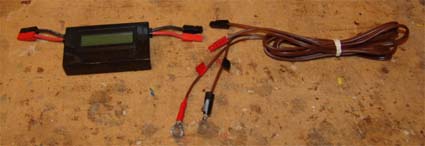
My Zip Chord Charger
Return to "What's In This Issue"
Upcoming New Jersey E-meet
From Rob rob.kallok@comcast.net
My club, the Jersey Coast Sport Fliers (AMA 1265), is having our 5th Annual Norm Hils Memorial Electric Fly-In on Saturday, July 5th. The event is held at our flying site in Dorbrook Park, which is located in Colts Neck, NJ. It's a great event and a fantastic site for an electric fly-in, with an all-grass strip and four flying stations. We get guys from NY and NJ attending the event, and we now have a regular contingent of SEFLI guys who make the trek from the island to our field.
Folks interested in more info on the fly-in, including directions and photos from the previous events, can visit our website at www.jcsportfliers.org. I can also be contacted as CD at 732-263-1561 or rob.kallok@comcast.net for more information.
Thanks again,
Rob
Return to "What's In This Issue"
A Beaver Takes to the Air
From Bill Mackey mackey77@gmail.com
Bill and I corresponded about using the TowerPro 3520-7 and the 2300mAh cells from A123 Systems, Inc. I received the following from Bill regarding his success. KM
Hi Ken,
I just did the maiden flight on my DeHavilland Beaver. I waited all day for the wind to die down. It finally dropped to a steady 10 mph gusting to 15 right across the runway. The temperature was 68 degrees, and the field elevation 1062 feet ASL.
The ready to fly weight was 104 ounces (6.5 lbs) and I used a 5-cell (5S1P) A123 Systems, Inc. 2300 mAh pack. The TowerPro 3520-7 motor turned an APC 14x7E prop.
It took off straight ahead in a short distance. The distance was less than a .46 flat wing trainer aircraft. It flew great at 1/2 throttle and climbed very well, exceptionally well.
I flew for 5 minutes and when I checked the battery voltage, it was down to 16.51 volts.
Hopefully this will be of interest to some. Clearly the motor/prop/battery combo will fly a 40 size sport aircraft. I might go a little smaller on the prop to reduce the amps.
Bill
And in a follow-up email
I flew the Beaver again today. The first flight was about two or three minutes. Then I did two more circuits around the field. I would guess about four or five minutes maximum total flight time. The battery voltage after the flights was down to 16.6 volts. (That's down to about 3.32v, not quite empty. KM) I just recharged the battery and voltage shows 17.1 volts. This is a 5-cell pack. I'm using a "Daptor" with my charger. Do these readings seem about right to you?
(Yes, but they could be a little higher, but not enough to be concerned with. As I noted earlier, mine are at about 3.45v to 3.5v after resting. KM)
One thing I have noticed. When throttling all the way back on final approach, the motor still seems to be "pulling" the aircraft. As the aircraft rolls to a stop, the prop stops. Is this to be expected? I'm thinking maybe the 7-inch pitch is wind milling more than I have seen in the past.
(I believe it is the large diameter prop giving the illusion of "pulling" as it is wind milling. KM)
Return to "What's In This Issue"
News from "Up North"
From John Zook johnzook@voyager.net
For those who don't remember, John is a former EFO member who has moved to the upper part of Michigan's lower peninsula. KM
I have been busy trying to get my Citabria ready for covering, a Gee Bee Tiger Moth refurbished as well as a Balsacraft FW-190 to a stage where I can glass the wing.
I'm also working on a Millennium Falcon...yes that's right....from Kirk Massey and I still have a lot of work to do on that one to get it ready: namely route out the servo well and wire channel for the ailerons and finish sanding the glassed joints where the wing sections were epoxied together. This should be a nice glider when finished. I'm going to power it with a Mega 22/30/3 and 2.5:1 ratio Inner driven gearbox. I have chosen a Rudy Freudenthaler spinner/prop combo from Soaring USA 14.5X14. These props are not cheap! The battery packs will be a 4S 3700mAh 20C Li-Po. Servos will be HS-81MG for rudder and elevator and HS-125MG for the ailerons. I had planned to fly it with a Mega Mini 7 and 3.5:1 box, but decided to go brushless with this one.
I also fly a Great Planes Spectra with a Multiplex 480-4G brushless motor and a 3S pack with a 4:1 ratio. It takes a 13x6.5 prop, but flies very well and with the lower weight of the Li-Pos, it has no trouble staying aloft.
Oh yeah, I seem to have developed an interest in powered gliders.
That's about all except that there is a group of us up here that are still looking for an indoor venue, but without success. All we have available are high school gyms and they seem to be in use all the time.
Hope all is well in the lower end of the state.
Cheers and stay healthy,
John Zook
Return to "What's In This Issue"
The March EFO Meeting
The March meeting was held on Thursday, March 13 at Rick Sawicki's house. It was well attended and we learned and shared a lot. Thanks again Rick for the use of your house!
Ken started the meeting by noting that the Mid-America Flies 2008 would be held on July 12 and 13 at the Midwest RC Society 7 Mile Rd. flying field in Northville Township, MI.
There were several planes for show and tell.
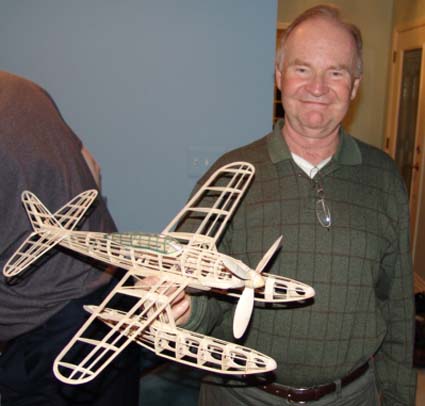
Pres showed off his rubber powered Aichi Seiran. Three of these aircraft were carried aboard an I-400 class Japanese submarine, the largest submarine of WWII. The sub was to have carried these planes within range of the Panama Canal to bomb it. There is quite a bit of interesting history in these planes and the sub. Pres was so intrigued with that history that he has built a model of the sub as well. Not to the scale of this model though. A model of the sub in the same scale as his plane would be HUGE!
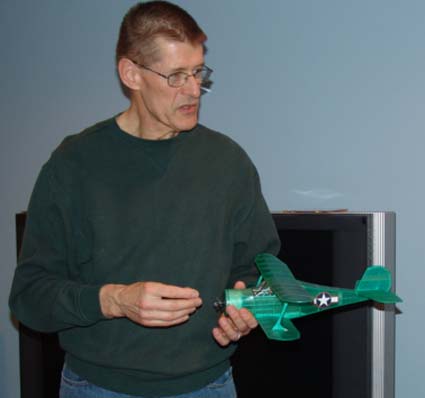
Dave shared his "Dime scale" 16" Staggerwing. He uses small magnets to keep the rubber "motor" in place as the rubber unwinds during the flight. The plane had its maiden flights earlier in the day and flies very well. The magnets do exactly what he wants them to do.
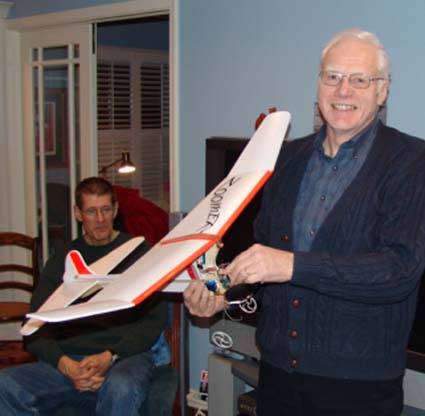
Arthur brought along his Zoomer. He had seen the slow flight characteristics of a similar model at the Mid-Am last year, and decided that he'd wanted a plane like it. There had been a construction article in Model Aviation of this Leon Shulman design, but this is the ARF version from Polk's Hobby. He's looking forward to flying it.
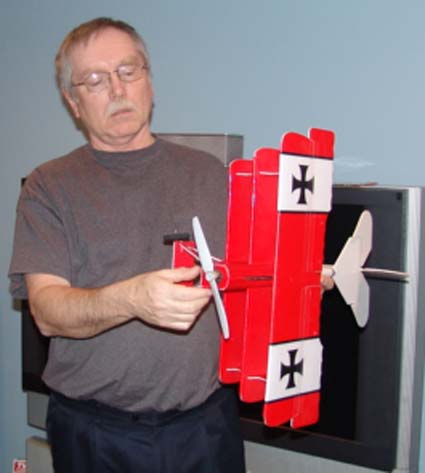
Richard showed off his 7.5 oz. all Depron Fokker DR.1.
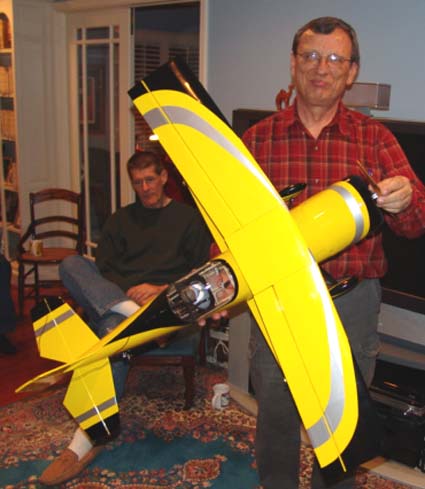
Rick shared a lot of information about his ZeroGravity Pitts Python 42" ARF powered by a Hacker A30-10XL. He thought that the plane was very well made. He pointed out many of its construction feathers.
Bob asked how many of us fly on 2.4Ghz. A few of the members do, but not all that many at this point. There was discussion about the JR/Spektrum type and Futaba type systems. Ken also noted that Airtronics now has a spread spectrum type radio as well. The May 2008 issue of FlyRC was shared with the members as it has an article on what happens when 40 of these transmitters are turned on at one time.
The general consensus of those not using the new technology is that it is just too costly to replace all of the receivers they are flying. A DSM2 AR6200 6-Channel Receiver Ultralite Spektrum is $80, while the popular Hitec Electron-6 with a crystal can be had for about $30 less. The other problem noted by the members is that once you decide on a "brand", you are stuck with it, as only the receivers from that "brand" will work with that type of spread spectrum. Ken also told the members that a representative from Futaba would be discussing their FASST 2.4Ghz system at the Skymasters' meeting on Wednesday, April 23 at Larson Middle School.
Grant Calkins had sent along a very nice video his "B-3" EDF powered flying wing. It is quite an interesting project! The members enjoyed seeing what Grant has been up to out in California. Thanks Grant!
After the video, many of the members went down into Rick's basement where we played "dodge the plane." Various members flew a couple of AirHog bipes and a small IR helicopter of Rick's. In the somewhat close quarters of his basement, dodging was a means of survival. It is quite fun to watch some folks dodging and swatting at the little pests! We even managed to have a mid-air between one of the bipes and the helicopter. Cool!
It was a fun night and the EFO members are all looking forward to getting out to do some outdoor flying together soon!
Return to "What's In This Issue"
CADding up a Tree Hugger
From Rick Benjamin rick.benjamin@verizon.net
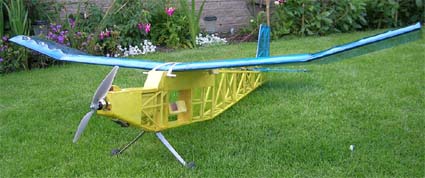
Ken;
I enjoy reading the Ampeer each month, thanks for all you do to make it happen.
Looks like your getting ready to have your plan laser cut.
I use TurboCAD. The learning breakthrough was when I learned to "edit" a line.
I liked the picture of an AP (aerial photograph KM) plane on RCGroups.
www.rcgroups.com/forums/showthread.php?t=666233&highlight=tree+hugger
I pasted the photo as the background of my cad sheet, and then drew discrete sections of the plane.
I've yet to build it. We're raising a grandson (one year old now) so I draw in the late evenings.
I sent the drawing to the guy in England, and got a real charge from him liking the plans as he scratch built the craft, no plans, one-of-a-kind.
Thanks again,
Rick Benjamin
Damascus, Oregon
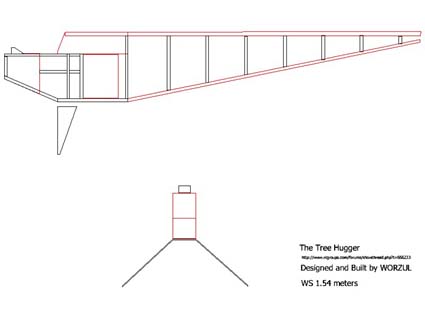 Return to "What's In This Issue"
Return to "What's In This Issue"
A P-51 and AT-6
From Don Hofeldt bladerunner1955@verizon.net
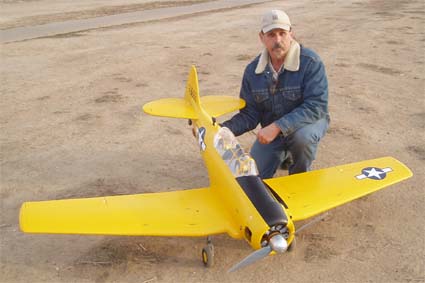
Thank you again for your web page. I always enjoy going though your information. I have attached a couple clips of the last two electric conversions. The P-51 is a Top Flight ARF, 84" wingspan, AXI 5345/16 on 12 cells, swings a 21x12 prop. The Texan is a Midwest kit. I did not build it, I just own it and did the e conversion. They both are using the same power system. The ESC is a Jeti Spin 90 amp on the Texan and only a 77 amp on the P-51. The amps on the P-51 are creeping up to the 75-amp range and so pushing the ESC. Sometimes it screams at me if I don't bleed off a little juice.
I hope you enjoy the clips. You will need to copy them and then paste them to your address bar. The second clip of the P-51 is from when I went out to Indio to fly with my friend who flies the same plane with a DA-50 in his. We both wanted to compare power. Even the gas guys said the electric was a little bit faster, even after he came down and leaned his out some.
www.youtube.com/watch?v=KWs8ZfS7xbg
www.youtube.com/watch?v=mn1s5UPZZY4
www.youtube.com/watch?v=RNTAhicEtBU
Thanks again for the web page. Let me know how you liked the clips and that you were able to open them.
Don Hofeldt the electric guy in Huntington Beach CA.
No problem opening the great videos. I enjoyed them very much. KM
Return to "What's In This Issue"
|










